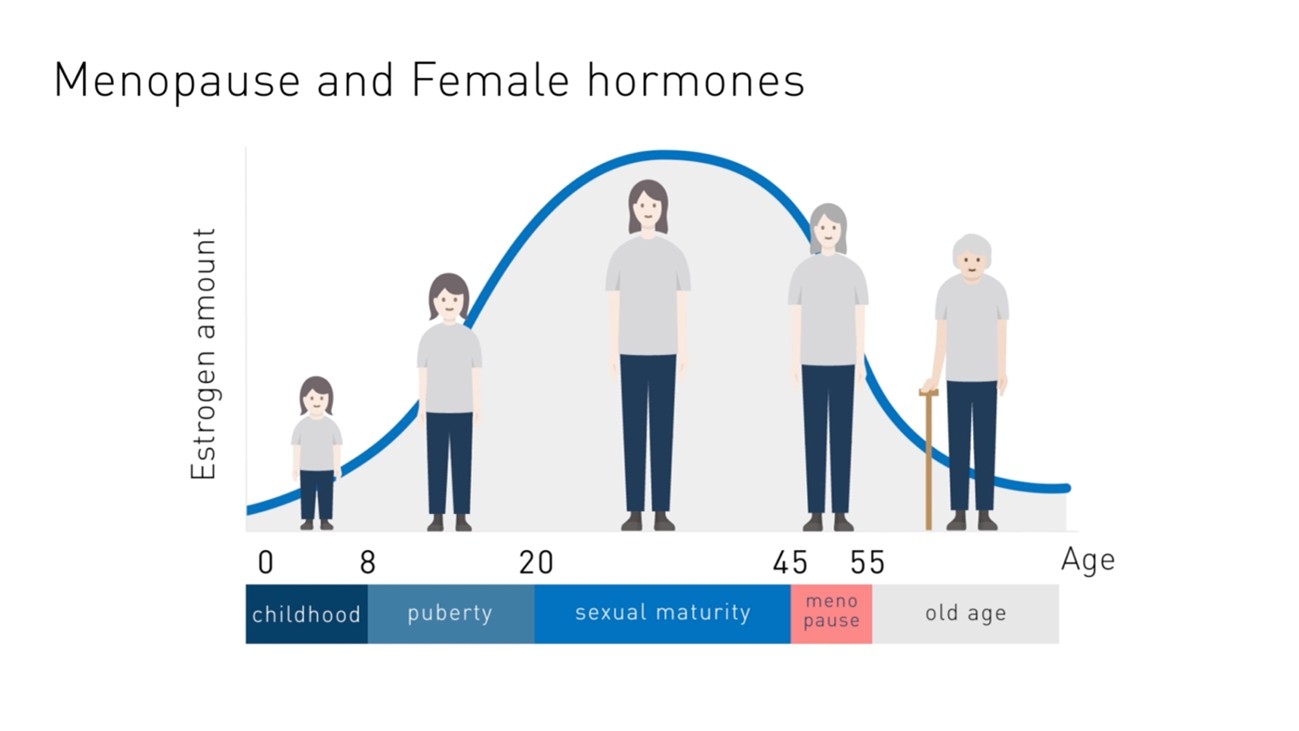The Hidden Link Between Menopause and Cardiovascular Risk
Cardiovascular risk doubles during menopausal transition
Cardiovascular disease (CVD) is the leading cause of death among women worldwide–and menopause plays a major role in this risk1.
Every year, 25 million women experience menopause, and by 2030, an estimated 1.2 billion women worldwide will be in post-menopause2. However, it is not widely known that many women do not receive appropriate care during this critical health transition.
Defining menopause and its duration
Menopause refers to the permanent cessation of menstruation and is clinically defined as the absence of menstruation for 12 consecutive months. Menopausal transition typically begins between the ages of 45 and 55 and can last 7–14 years. This extended transition period involves significant hormonal fluctuations, particularly characterized by declining estrogen levels3,4. The reduction in estradiol is estimated to be approximately 60%, and this substantial decrease is closely associated with an increased cardiovascular risk5,6.
 How hormonal shifts affect the cardiovascular system
How hormonal shifts affect the cardiovascular system
Estrogen stabilizes the autonomic nervous system, supports bone health, and even plays a role in protecting cardiovascular health. It helps maintain the flexibility of arterial walls, promotes healthy blood flow, and contributes to increasing good cholesterol (HDL)7. Therefore, a significant decline in estrogen secretion can easily lead to reduced vascular elasticity and lipid metabolism abnormalities, contributing to atherosclerosis and hypertension. Consequently, this increases the risk of developing serious diseases such as strokes and heart failure. The risk of ischemic stroke in women doubles between the ages of 55 and 65, a period that coincides precisely with menopausal transition5,6.
Gaps in Awareness and Self-Care
Cardiovascular risk in menopausal women remains underestimated
A survey conducted by OMRON Healthcare in Japan among 1,000 women aged 20–60 revealed that even when experiencing symptoms like palpitations or shortness of breath, most women did not seek medical care. Additionally, research indicates that 85-90% of women who suffered an acute myocardial infarction recognized early symptoms prior to onset8. Many view these symptoms as a natural part of aging, and awareness that blood pressure tends to rise during and after menopause is limited. While some sought medical attention, in many cases the symptoms were overlooked or misdiagnosed. It is not uncommon for healthcare providers to dismiss or downplay these complaints, highlighting a significant lack of appropriate and gender-sensitive care.
 Risks unique to women and the need for countermeasures
Risks unique to women and the need for countermeasures
Historically, cardiovascular research has focused on men, leading to an underestimation of women’s risks. This may partly explain why women have a higher rate of sudden cardiac death compared with men. Statistics show that about 40% of women develop hypertension during or after menopause. While men under 60 are more likely to have uncontrolled hypertension, women over 60 are less likely than men of the same age to keep their blood pressure under control9.
Thus, menopausal women exhibit specific risk factors and symptoms associated with declining estrogen levels, presenting a distinct risk profile from men10. Consequently, it is imperative to reform the mindset of female healthcare providers, enhance their understanding of female-specific symptom patterns, and have women improve their own health literacy. Menopause must be recognized not merely as a natural aging process, but as a critical health transition period where cardiovascular disease risk increases dramatically.
Monitoring at Home
Tracking blood pressure and heart rhythm from home
With the use of blood pressure monitors equipped with ECG functions or portable ECG devices, women can detect early signs of cardiovascular risk. OMRON Healthcare’s Intellisense AFib technology enables the detection of atrial fibrillation during home blood pressure measurements, helping prevent cardiovascular risks.
 Simple monitoring through apps and seamless physician support
Simple monitoring through apps and seamless physician support
The OMRON Connect app allows users to track not only blood pressure but also physical conditions and sleep patterns in one place. This makes it easier to identify health trends, share data with healthcare providers, and act on risks early.
Daily self-monitoring can uncover high blood pressure–often symptomless–leading to earlier diagnosis and better management. By making home monitoring a routine habit, women can significantly reduce their risk and detect problems before they escalate.
OMRON Healthcare’s Commitment to Education and Awareness
Educating healthcare professionals
Healthcare providers gain access to the latest knowledge on cardiovascular risks of menopausal women through the OMRON Academy e-learning platform, enabling earlier detection in clinical practice.
 Informing the public
Informing the public
OMRON Healthcare uses its website and social media channels to explain the connection between menopause, blood pressure, and heart health in clear, accessible ways.
Collaborating with academia
To address the lack of women-specific data, OMRON Healthcare collaborates with research institutions worldwide to generate evidence-based awareness campaigns.
These efforts aim to spread the understanding that menopause is a turning point for cardiovascular risk and to raise women’s health awareness through media coverage and outreach.
Building a Society Where Women Can Navigate Menopause with Confidence
Promoting awareness and support across society
Menopause is a critical stage of life, marked by physical and emotional changes and a sharp rise in blood pressure and cardiovascular risks. Yet limited awareness and low rates of medical consultation leave many women without proper prevention or care.
OMRON Healthcare’s global vision, Going for Zero: zero heart attacks and zero strokes, drives its comprehensive approach, from home monitoring devices to professional education and collaborative research. By viewing menopause as an opportunity to reassess cardiovascular health, we aim to build a society where women can embrace the stage of life during and after menopausal transition with confidence and peace of mind.
References
- Rajendran, A. (November 2023)
- Cleveland Clinic Menopause. (2024). Menopause. Retrieved from Cleveland Clinic: https://my.clevelandclinic.org/health/diseases/21841-menopause
- Cleveland Clinic Perimenopause. (2024). Perimenopause. Retrieved from Cleveland Clinic: https://my.clevelandclinic.org/health/diseases/21608-perimenopause3
- Cove CL, e. a. (Mar 2024). Female sex as an independent risk factor for stroke in atrial fibrillation: possible mechanisms. Thromb Haemost., 3;111(3):385-91.
- Du L, e. a. (Apr 2020). Menopausal Symptoms and Perimenopausal Healthcare-Seeking Behavior in Women Aged 40-60 Years. Int J Environ Res Public Health, 12;17(8):2640.
- El Khoudary SR, e. a. (Dec 2020). Implications for Timing of Early Prevention: A Scientific Statement From the American Heart Association. Circulation, 22;142(25):e506-e532.
- Kelly-Hayes, M. (Oct 2010). Influence of age and health behaviors on stroke risk: lessons from longitudinal studies. J. Am Geriatr Soc., S325-8.
- Cleveland Clinic Estrogen and Heart Health. (n.d.). Estrogen and Heart Health. Retrieved from Cleveland Clinic: https://health.clevelandclinic.org/estrogen-and-heart-health
- McSweeney, J. (Nov 2003). Women's early warning symptoms of acute myocardial infarction. Circulation, 25;108(21):2619-23.
- Satish, P. (May 2024). Understanding the spectrum of cardiovascular risk in women - A primer for prevention. Prog Cardiovasc Dis, 84:34-42.

